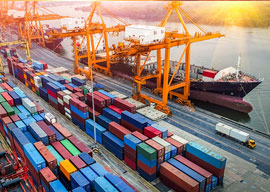Pakistan customs import-export data is an analytically designed powerful tool that consists of several crucial and valuable information of different fields in the trade business.
The custom import-export data that Exim Trade Data offers includes major fields of crucial and essential details such as HS Code, Name of Importer & Exporter, Address of Importer & Exporter, Product Description, Port Name & Details, Shipment & Consignment Details, Unit, Rates, Value, Quantity. Weight and Date etc.
According to the reports. Pakistan was the 51st largest importer and 68th largest exporter country in the world in the year 2019.
Year-wise Import-Export Value of Pakistan Trade Business
Based on Pakistan Import Data, given below are the total import trade value of Pakistan according to Pakistan import data year wise:
● In 2017, the total import of Pakistan was $53.59 billion, an increase of 19% from 2016.
● In 2018, the total import of Pakistan was $63.14 billion, an increase of 17.82% from 2017.
● In 2019, the total import of Pakistan was $56.53 billion, a decline of 10.46% from 2018.
● In 2020, the total import of Pakistan was $43.86 billion, a decline of 22.42% from 2019.
Export Trade Data
Given below stats are based on Pakistan export data, and the total export value of Pakistan is shown as per Pakistan export data year wise:
● In 2017, the total export of Pakistan was $25.15 billion, a decline of 1.32% from 2016.
● In 2018, the total export of Pakistan was $28.22 billion, an increase of 12.22% from 2017.
● In 2019, the total export of Pakistan was $28.15 billion, a decline of 0.25% from 2018.
● In 2020, the total export of Pakistan was $25.26 billion, a decline of 10.29% from 2019.
What are the Main Exports of Pakistan?
Based on markets research reports and Pakistan export data 2020, Miscellaneous Textiles & Worn Clothing $4.3 billion (19.2%), Cereals $2.1 billion (9.5%), Knit or Crochet Clothing & Accessories $3.1 billion (13.8%), Clothing Accessories (Not Knit or Crochet) $2.6 billion (11.8%), Cotton $2.6 billion (11.9%), Technical, Optical & Medical Apparatus $380.5 million (1.7%), Leather & Animal Gut Articles $583.4 million (2.6%), Cement, Sulphur, Salt & Stone $423 million (1.9%), Copper $435.3 million (2%), and Edible Fruits & Nuts $418.6 million (1.9%) were some of the most exported products of Pakistan according to Pakistan Export Data and trade statistics.
Pakistan’s Exports Trade Data 2020 by Country
Market analysis reports and research data suggest that the United States of America $4.14 billion (18.6%), China $1.86 billion (8.39%), United Kingdom $1.72 billion (7.76%), United Arab Emirates $1.09 billion (4.93%), Germany $1.39 billion (6.27%), Netherlands $1.09 billion (4.92%), Spain $794 million (3.57%), Afghanistan $870 million (3.91%), Bangladesh $583 million (2.62%), and Italy $718 million (3.23%) were the top export partner countries of Pakistan according to Pakistan export data 2020 by country.
To ensure that the data we provide is 100% genuine, authentic, and reliable we source data from various authorized sources of links such as Authorized Customs Departments, Logistics & Shipping Companies, Trade Associations, Port Authorities, Government Bodies, and some other authoritative links.
For more info on any global country, you can visit our official website and ask for free sample data or even book a free demo to get the overall overview of your trade business.






